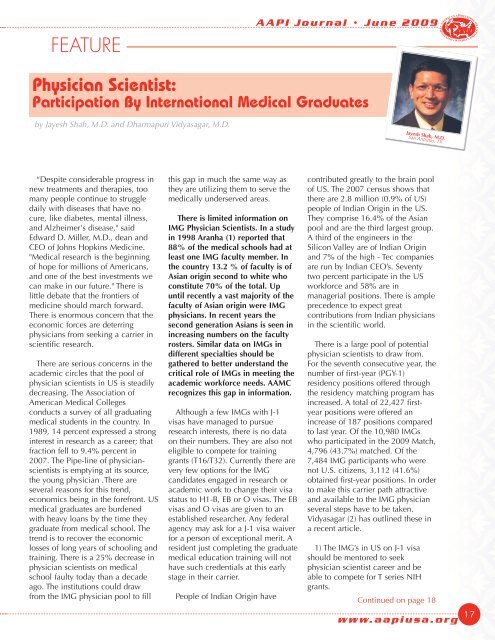Physician Scientist - American Association of Physicians of Indian ...
Physician Scientist - American Association of Physicians of Indian ...
Physician Scientist - American Association of Physicians of Indian ...
Create successful ePaper yourself
Turn your PDF publications into a flip-book with our unique Google optimized e-Paper software.
FEATURE<br />
AAPI Journal • June 2009<br />
<strong>Physician</strong> <strong>Scientist</strong>:<br />
Participation By International Medical Graduates<br />
by Jayesh Shah, M.D. and Dharmapuri Vidyasagar, M.D.<br />
Jayesh Shah, M.D.<br />
San Antonio, TX<br />
“Despite considerable progress in<br />
new treatments and therapies, too<br />
many people continue to struggle<br />
daily with diseases that have no<br />
cure, like diabetes, mental illness,<br />
and Alzheimer's disease," said<br />
Edward D. Miller, M.D., dean and<br />
CEO <strong>of</strong> Johns Hopkins Medicine.<br />
"Medical research is the beginning<br />
<strong>of</strong> hope for millions <strong>of</strong> <strong>American</strong>s,<br />
and one <strong>of</strong> the best investments we<br />
can make in our future." There is<br />
little debate that the frontiers <strong>of</strong><br />
medicine should march forward.<br />
There is enormous concern that the<br />
economic forces are deterring<br />
physicians from seeking a carrier in<br />
scientific research.<br />
There are serious concerns in the<br />
academic circles that the pool <strong>of</strong><br />
physician scientists in US is steadily<br />
decreasing. The <strong>Association</strong> <strong>of</strong><br />
<strong>American</strong> Medical Colleges<br />
conducts a survey <strong>of</strong> all graduating<br />
medical students in the country. In<br />
1989, 14 percent expressed a strong<br />
interest in research as a career; that<br />
fraction fell to 9.4% percent in<br />
2007. The Pipe-line <strong>of</strong> physicianscientists<br />
is emptying at its source,<br />
the young physician .There are<br />
several reasons for this trend,<br />
economics being in the forefront. US<br />
medical graduates are burdened<br />
with heavy loans by the time they<br />
graduate from medical school. The<br />
trend is to recover the economic<br />
losses <strong>of</strong> long years <strong>of</strong> schooling and<br />
training. There is a 25% decrease in<br />
physician scientists on medical<br />
school faulty today than a decade<br />
ago. The institutions could draw<br />
from the IMG physician pool to fill<br />
this gap in much the same way as<br />
they are utilizing them to serve the<br />
medically underserved areas.<br />
There is limited information on<br />
IMG <strong>Physician</strong> <strong>Scientist</strong>s. In a study<br />
in 1998 Aranha (1) reported that<br />
88% <strong>of</strong> the medical schools had at<br />
least one IMG faculty member. In<br />
the country 13.2 % <strong>of</strong> faculty is <strong>of</strong><br />
Asian origin second to white who<br />
constitute 70% <strong>of</strong> the total. Up<br />
until recently a vast majority <strong>of</strong> the<br />
faculty <strong>of</strong> Asian origin were IMG<br />
physicians. In recent years the<br />
second generation Asians is seen in<br />
increasing numbers on the faculty<br />
rosters. Similar data on IMGs in<br />
different specialties should be<br />
gathered to better understand the<br />
critical role <strong>of</strong> IMGs in meeting the<br />
academic workforce needs. AAMC<br />
recognizes this gap in information.<br />
Although a few IMGs with J-1<br />
visas have managed to pursue<br />
research interests, there is no data<br />
on their numbers. They are also not<br />
eligible to compete for training<br />
grants (T16/T32). Currently there are<br />
very few options for the IMG<br />
candidates engaged in research or<br />
academic work to change their visa<br />
status to H1-B, EB or O visas. The EB<br />
visas and O visas are given to an<br />
established researcher. Any federal<br />
agency may ask for a J-1 visa waiver<br />
for a person <strong>of</strong> exceptional merit. A<br />
resident just completing the graduate<br />
medical education training will not<br />
have such credentials at this early<br />
stage in their carrier.<br />
People <strong>of</strong> <strong>Indian</strong> Origin have<br />
contributed greatly to the brain pool<br />
<strong>of</strong> US. The 2007 census shows that<br />
there are 2.8 million (0.9% <strong>of</strong> US)<br />
people <strong>of</strong> <strong>Indian</strong> Origin in the US.<br />
They comprise 16.4% <strong>of</strong> the Asian<br />
pool and are the third largest group.<br />
A third <strong>of</strong> the engineers in the<br />
Silicon Valley are <strong>of</strong> <strong>Indian</strong> Origin<br />
and 7% <strong>of</strong> the high - Tec companies<br />
are run by <strong>Indian</strong> CEO’s. Seventy<br />
two percent participate in the US<br />
workforce and 58% are in<br />
managerial positions. There is ample<br />
precedence to expect great<br />
contributions from <strong>Indian</strong> physicians<br />
in the scientific world.<br />
There is a large pool <strong>of</strong> potential<br />
physician scientists to draw from.<br />
For the seventh consecutive year, the<br />
number <strong>of</strong> first-year (PGY-1)<br />
residency positions <strong>of</strong>fered through<br />
the residency matching program has<br />
increased. A total <strong>of</strong> 22,427 firstyear<br />
positions were <strong>of</strong>fered an<br />
increase <strong>of</strong> 187 positions compared<br />
to last year. Of the 10,980 IMGs<br />
who participated in the 2009 Match,<br />
4,796 (43.7%) matched. Of the<br />
7,484 IMG participants who were<br />
not U.S. citizens, 3,112 (41.6%)<br />
obtained first-year positions. In order<br />
to make this carrier path attractive<br />
and available to the IMG physician<br />
several steps have to be taken.<br />
Vidyasagar (2) has outlined these in<br />
a recent article.<br />
1) The IMG’s in US on J-1 visa<br />
should be mentored to seek<br />
physician scientist career and be<br />
able to compete for T series NIH<br />
grants.<br />
Continued on page 18<br />
www.aapiusa.org<br />
17

















